- There are no more items in your cart
- Shipping Calculated at checkout
- Sub-Total (inc. VAT) £0.00
Need Help?
Fire Protection for Plasterboard
Buy specialist intumescent paint fire protection and fireproofing finishes for plasterboard, with 4,400+ colours available in up to 60 minutes fire protection. Choose from top fire protection manufacturers including Thermoguard, Tor, and Protecta, with fire certificates available on completion.
If you require more help to find and specify fire protection for your project or contract, our technical team are always on hand to advise. Give us a call on 0113 2455450 (option 2) or send a message to [email protected].
Subcategories
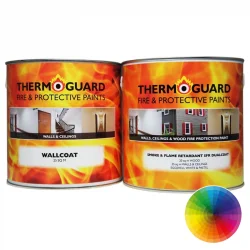
Thermoguard Wallcoat BS Class 1/0 & EN Class B System
Fire retardant paint system in 4,000+ colours for interior plasterboard ceiling and wall surfaces. Each pack contains the correct amount of basecoat (Wallcoat Insulating Basecoat) and topcoat (Wallcoat Smoke & Flame Retardant Topcoat) to ensure protection is achieved inline with the manufacturers recommendations to the respective area in...
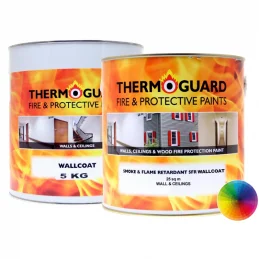
Thermoguard Wallcoat 30 & 60 Minute System for Plasterboard
Intumescent paint system with 4,000+ colour options for interior plasterboard and cement board ceiling and wall surfaces. These packs have been created to help users ensure they are purchasing sufficient product for their project. Each pack contains the correct amount of basecoat (Wallcoat) and topcoat (Thermoguard Wallcoat Smoke & Flame...
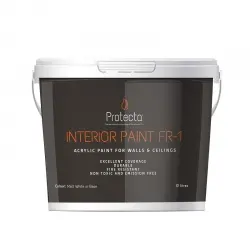
Protecta Interior Paint FR-1
Single-pack fire-rated acrylic paint providing fire resistance for walls and ceilings. Available in white and 27 colours. Suitable for application on wood, concrete, bricks, masonry, primed steel, gypsum, plastics, and most non-porous surfaces. Transforms combustible wood surfaces into fire-rated, CE-marked walls and ceilings without...
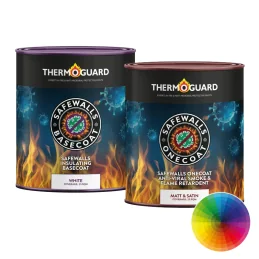
Thermoguard Safewalls Anti-Viral Fire Protection System
Fire protection system containing correct quantities of Safewalls Insulating Basecoat and Safewalls Onecoat Anti-Viral Smoke & Flame Retardant for 25m², 50m² and 100m² coverage respectively. Protects walls and ceilings covered with Wallpaper (but not vinyl) and Multi-Layer Paints.Contains CORONA-KILL® 99% bacteria reduction in 24...
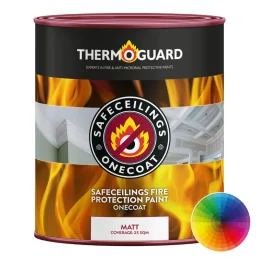
Thermoguard Safeceilings Onecoat Ultra Matt
Flame Retardant Intumescent protection in one coat for painted or new primed ceilings, in 1,400+ matt and LRV colours. Durability and infection control are much less needed on ceilings and areas free from wear and tear.Decorative fire upgrade and finish in one coat Protects ceilings to BS EN Class B & Class OPlease Note: Onecoat...
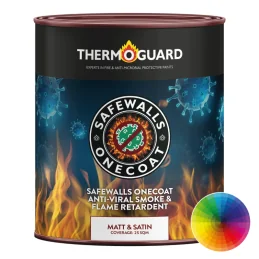
Thermoguard Safewalls Onecoat Anti-Viral Smoke & Flame Retardant
Anti-viral fire protection for painted walls in a single coat, with 4000+ matt and satin colour options including LRV. Kills Coronavirus, Flu and bacteria fast. Safewall’s highly concentrated mix of safe, encapsulated nano-particle biocidal metals damage the shells of human coronaviruses and flu and the membranes of bacteria, so their death...
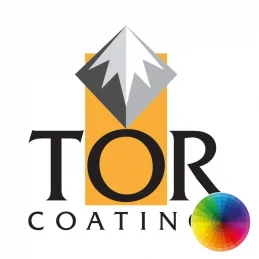
Tor Torrex Flame Retardant Anti-Graffiti
A durable water based anti-graffiti flame retardant finish in 1,600+ gloss colours. For use over low risk existing multi-layered painted surfaces to reduce the spread of flame in communal areas in the event of a fire.Two coats of Torrex Flame Retardant Anti-Graffiti will convert 12 coats of conventional water based coatings to Class 0 when...
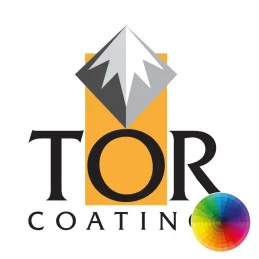
Tor Torrex Flame Retardant Matt
1,600+ water based matt decorative colours in a flame retardant finish. For use over low risk existing multi-layered painted surfaces to reduce the spread of flame in communal areas in the event of a fire.Two coats of Torrex Flame Retardant Matt will convert 12 coats of conventional water based coatings to Class 0 when tested to BS476...
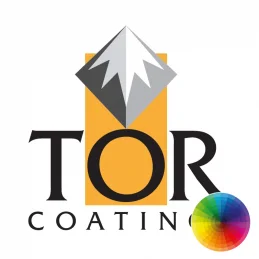
Tor Torrex Flame Retardant Eggshell
Durable flame retardant finish in 4,400+ water based eggshell colours. For use over low risk existing multi-layered painted surfaces to reduce the spread of flame in communal areas in the event of a fire.Two coats of Torrex Flame Retardant Eggshell will convert 12 coats of conventional water based coatings to Class 0 when tested to BS476...
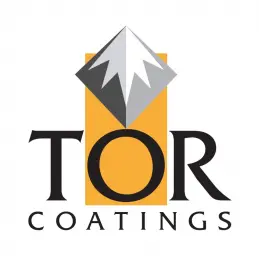
Tor Torrex Flameshield Ultimate Build Coat
High build intumescent coating (part of the Torrex Flameshield Ultimate System) for use over Torrex Ultimate Primer on existing multi-layered painted surfaces to reduce the spread of flame in the event of a fire.Only to be applied over Torrex Ultimate PrimerAllows users to upgrade the fire performance of existing coatings on walls and...
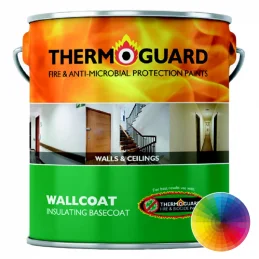
Thermoguard Wallcoat Insulating Basecoat
Intumescent basecoat to Thermoguard Wallcoat Smoke and Flame Retardant Topcoat in 4,000 colours,to upgrade potentially dangerous ‘multi-layer’ - previously painted - walls & ceilings in communal areas.Achieves EN Class B s1 d0 spread of flame on walls and ceilings Exceptional adhesion and permanent protection For painted plaster,...
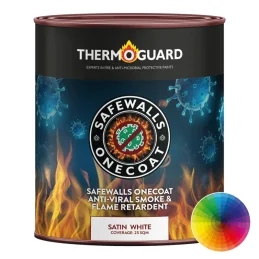
Thermoguard Safewalls Anti-Viral Smoke & Flame Retardant Topcoat
This product is due to be discontinued once existing stock has depleted; if the quantity you require is unavailable we can recommend Thermoguard Safewalls Onecoat Anti-Viral Smoke & Flame Retardant as a great alternative. For use over Thermoguard Safewalls Insulating Basecoat - rapidly accelerates the death of Corona and Flu viruses,...
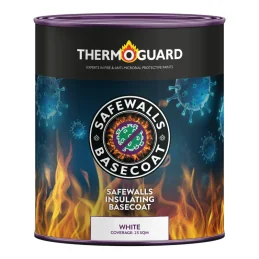
Thermoguard Safewalls Insulating Basecoat
Achieves EN Class B s1 d0 as part of a two-coat system on walls painted with any number or combination of coats of any and all types of sound internal wall paints.Exceptional adhesion Permanent protection Anti-Viral and Anti-Bacterial Please note that colours chosen in this product will be produced as an `undercoat shade` ready for...
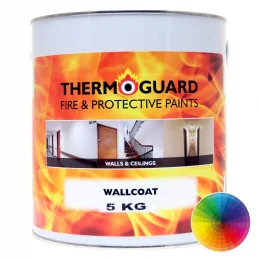
Thermoguard Wallcoat
Intumescent basecoat in 4,000 colours for overcoating with Thermoguard Wallcoat Smoke and Flame Retardant Topcoat to upgrade potentially dangerous 'multi-layer' - previously painted - walls and ceilings in communal areas to 30 or 60 minutes protection.Achieves EU and new British safety standards on walls and ceilings For painted plaster,...
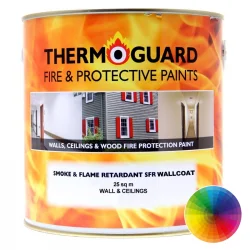
Thermoguard Wallcoat Smoke & Flame Retardant Topcoat
Fire-retardant paint in 4,000+ colours for walls and ceilings. Works in combination with Thermoguard Wallcoat Insulating Basecoat.Fire Certificate available on request Controls surface spread of flame and fire propagation Interior & exterior use Controls smoke and flaming droplets/particulates to BS EN Class B s1 d0 (as part of a...
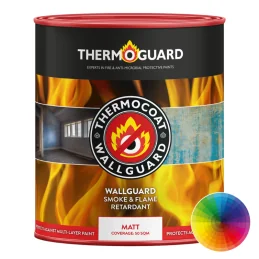
Thermoguard Wallguard Smoke & Flame Retardant Topcoat
Fire-retardant paint in 4,000+ colours for walls and ceilings. Works in combination with Thermoguard Wallcoat Insulating Basecoat.Fire Certificate available on request. Controls surface spread of flame and fire propagation. Interior use. Controls smoke and flaming droplets/particulates to BS EN Class B s1 d0 (as part of a complete...
Need Help?
Need Help?
About Fire Protection for Plasterboard
Fire protection paints for plasterboard, also known as intumescent coatings, are a crucial component of passive fire protection systems. These paints are designed to enhance the fire resistance of plasterboard, thereby improving the overall fire safety of buildings. When exposed to high temperatures, intumescent paints swell and form an insulating char layer, which helps to protect the underlying material from fire. This reaction effectively increases the fire resistance of plasterboard, enabling it to maintain its structural integrity for longer periods during a fire event .
The application process of fire protection paints for plasterboard is meticulous and requires adherence to manufacturer guidelines to ensure optimal performance. The surface must be properly prepared, free from dust, grease, and previous coatings, to ensure good adhesion of the intumescent paint. Depending on the specific product and application requirements, the paint can be applied using brushes, rollers, or spray equipment. Multiple coats may be necessary to achieve the desired fire resistance rating, from surface spread ratings and timed ratings starting at 30 mins, depending on the thickness of the applied paint and the specific formulation used .
Testing and certification are critical aspects of ensuring the effectiveness of fire protection paints. These products undergo rigorous fire testing to comply with standards such as BS 476 Part 6 and Part 7 in the UK, which measure fire propagation and surface spread of flame, respectively. Additionally, European standards such as EN 13501-1 may also be used. These tests simulate real fire conditions to verify the paint’s ability to protect the plasterboard under specified conditions. Properly certified fire protection paints contribute significantly to the overall fire safety strategy of buildings, helping to control the spread of fire and providing valuable time for evacuation and firefighting efforts.
Types of Fire Protection for Plasterboard
Fire-Resistant Plasterboard
Fire-resistant plasterboard is manufactured to provide improved fire resistance compared to standard plasterboard. These boards are often reinforced with glass fibres and other additives to enhance their fire-retardant properties. They are typically used in:
- Walls and Partitions: Used to construct walls and partitions that require higher fire ratings.
- Ceilings: Installed in ceilings to prevent the spread of fire between floors.
- Structural Protection: Applied to structural elements to prevent collapse during a fire.
Intumescent Coatings
Intumescent coatings are applied to the surface of plasterboard to enhance its fire resistance. When exposed to heat, these coatings expand and form a thick, insulating char layer. This layer protects the plasterboard by:
- Insulating against heat: Reducing the rate of temperature rise.
- Sealing gaps: Preventing the passage of smoke and hot gases.
Intumescent coatings are especially useful for steel structures, coating plasterboard used to protect steel structures.
Fire-Resistant Compounds
Fire-resistant compounds are used to seal joints and penetrations in plasterboard assemblies. These compounds ensure that the integrity of the fire barrier is maintained by:
- Sealing gaps and joints: Preventing the spread of fire and smoke through seams.
- Penetration seals: Providing protection where pipes, cables, and ducts pass through walls and floors.
Insulation and Cladding Systems
Fire-resistant plasterboard is often used as part of larger insulation and cladding systems designed to resist high temperatures. These systems provide:
- Thermal insulation: Reducing the rate of heat transfer.
- Protective barriers: Offering additional layers of fire protection.
Common applications include:
- Roofing systems: Insulating layers that prevent fire spread through the roof.
Compartmentation
Plasterboard is a key component in creating fire compartments within a building. Fire compartments are designed to contain fire and smoke within a specific area, preventing it from spreading to other parts of the building. This is achieved through:
- Fire-resisting walls and floors: Constructed with fire-resistant plasterboard.
- Fire doors: Installed in compartment walls to maintain fire separation.
- Fire-resisting glazing: Used in walls and doors to allow visibility while providing fire resistance.
Surface Treatments
Surface treatments such as fire-resistant paints are applied to plasterboard to improve its fire performance. These treatments work by:
- Reducing ignitability: Making it harder for the surface to catch fire.
- Limiting flame spread: Preventing flames from spreading across the surface.
- Enhancing thermal insulation: Reducing the rate of heat transfer through the surface.
Fire Testing and Certification
All fire protection materials and systems must undergo rigorous fire testing to ensure they meet the necessary safety standards. This includes:
- Fire resistance tests: Evaluating the ability of materials to withstand fire for a specified period.
- Reaction to fire tests: Assessing how materials react when exposed to fire, including ignitability, flame spread, and heat release.
In the UK, common standards include:
- BS 476 Series: A set of British Standards covering various aspects of fire testing.
- BS EN Tests: European standards that provide classifications based on fire performance, known as Euroclasses.
Key Standards and Classifications
- BS 476 Part 6: Measures fire propagation (heat release).
- BS 476 Part 7: Measures surface spread of flame.
- EN 13501-1: European classification standard for the reaction to fire performance of building materials.
These standards ensure that plasterboard and associated fire protection systems provide adequate safety and performance in the event of a fire.
Applications of Fire Protection Paints for Plasterboard
Fire protection paints for plasterboard are used in various parts of buildings to enhance fire safety by controlling the spread of fire and smoke. These paints are primarily employed in the following areas:
Walls and Partitions
Fire protection paints are applied to plasterboard walls and partitions to improve their fire resistance. This helps to contain fires within a designated area, preventing the spread to other parts of the building. By enhancing the fire resistance of walls, these paints play a critical role in maintaining the structural integrity of the building during a fire.
Ceilings
Plasterboard ceilings coated with fire protection paints are crucial in preventing the vertical spread of fire. This application ensures that fire does not easily penetrate through the ceiling to floors above, thereby containing the fire within a single compartment for a longer period.
Escape Routes
Ensuring safe evacuation during a fire is paramount. Fire protection paints are used on plasterboard in escape routes, such as corridors and stairwells, to maintain their integrity and prevent the spread of smoke and flames. This helps to provide a safe passage for occupants to exit the building.
Structural Elements
Plasterboard used as a covering for structural elements like beams and columns can be treated with fire protection paints. This application helps to protect the structural integrity of the building by delaying the onset of failure of these critical components during a fire.
Building Types and Specific Uses
Fire protection paints for plasterboard are essential in residential buildings to enhance fire safety and ensure compliance with building regulations. These paints help to prevent the spread of fire, protect structural integrity, and ensure safe evacuation routes. Below is an expanded overview of their use in different types of residential buildings and specific areas within these buildings.
Residential Buildings
Single-Family Homes
- Detached Houses: These standalone homes benefit from fire protection paints applied to plasterboard, providing a critical barrier that can prevent the spread of fire between rooms and levels.
- Semi-Detached Houses: In semi-detached houses, where two units share a common wall, fire protection paints can help prevent fire from spreading between the two residences.
- Terraced Houses: These houses share walls with neighbours on both sides, making fire protection even more essential. Applying fire-resistant coatings to internal walls and ceilings can help contain fires within a single unit.
Multi-Family Residences
- Apartments and Flats: In multi-story buildings, fire protection paints can be applied to internal walls and ceilings to prevent the vertical and horizontal spread of fire, safeguarding multiple units.
- Duplexes and Triplexes: These buildings, which contain two or three separate living units, often benefit from fire protection paints to ensure that a fire in one unit does not quickly spread to others.
- Townhouses: Similar to terraced houses but often part of larger developments, townhouses can use fire protection paints to enhance the safety of each individual unit.
High-Rise Residential Buildings
- Condominiums: High-rise buildings where each unit is individually owned can use fire protection paints to protect common areas, escape routes, and individual apartments from fire.
- Rental Apartments: In rental buildings, applying fire protection paints can help meet safety regulations and provide peace of mind to tenants regarding fire safety.
Special Housing
- Student Accommodation: Dormitories and student housing can benefit from fire protection paints to ensure safe evacuation routes and prevent the rapid spread of fire, which is critical in buildings with high occupancy density.
- Senior Living Facilities: In buildings designed for elderly residents, fire protection paints on plasterboard can help protect vulnerable populations by providing more time for evacuation and reducing smoke spread.
- Social Housing: Government-provided or subsidised housing can use fire protection paints to ensure high safety standards and protect residents from fire hazards.
2. Commercial Buildings:
Commercial buildings encompass a wide range of structures including offices, retail spaces, hotels, and more. These buildings typically have high occupancy levels, valuable assets, and critical operations that require robust fire protection measures.
Specific Areas and Uses
Offices:
- Corporate Offices: High-rise office buildings and business complexes often require enhanced fire protection measures to ensure the safety of numerous employees and to safeguard important documents and equipment.
- Small Business Offices: Smaller office spaces, such as those in standalone buildings or part of a mixed-use development, can also benefit from fire protection paints to protect occupants and assets.
Retail Spaces:
- Shopping Centres and Malls: Large retail complexes with multiple stores and high foot traffic need robust fire protection to ensure the safety of shoppers and staff.
- Standalone Retail Stores: Individual shops, whether part of a high street or a retail park, can use fire protection paints to comply with safety regulations and protect goods and customers.
Hospitality Industry:
- Hotels: With many guests and staff, hotels require enhanced fire protection to ensure safe evacuation routes and to prevent the spread of fire through common areas and guest rooms.
- Restaurants and Cafes: These establishments often have higher fire risks due to cooking activities, making fire protection paints crucial for walls and ceilings to control any potential fires.
Entertainment Venues:
- Cinemas and Theatres: Venues with large numbers of occupants in confined spaces need effective fire protection measures to ensure safe egress and to protect structural integrity.
- Concert Halls and Arenas: Similar to cinemas and theatres, these large spaces benefit from fire protection paints to manage fire risks and safeguard large crowds.
Warehouses and Storage Facilities:
- Logistics Centres: Warehouses handling large volumes of goods need fire protection to manage the risk of fire spread, particularly in areas where combustible materials are stored.
- Distribution Hubs: Fire protection paints help in maintaining the integrity of fire compartments, ensuring that fire does not spread to critical storage areas.
Healthcare-Related Commercial Buildings:
- Private Clinics and Laboratories: Facilities providing medical services or conducting research need to ensure that fire risks are minimized to protect patients, staff, and sensitive equipment.
- Pharmaceutical Facilities: These buildings, involved in the production and storage of medications, require stringent fire protection measures to prevent damage and ensure safety.
Mixed-Use Developments:
- Buildings with Commercial and Residential Units: Mixed-use buildings that combine commercial spaces with residential units need comprehensive fire protection to safeguard all occupants and prevent fire spread between different areas.
3. Industrial Buildings:
Manufacturing Plants:
- In facilities where goods are produced, there are often significant fire risks due to the presence of machinery, flammable materials, and high temperatures. Fire protection paints can help in protecting the structural integrity of these buildings and providing additional time for evacuation and firefighting efforts.
Warehouses:
- Warehouses store large quantities of goods, which can include flammable materials. Applying fire protection paints to plasterboard walls and ceilings helps to contain fires, protecting both the inventory and the structural components of the building.
Chemical Plants:
- These facilities handle hazardous chemicals that can pose severe fire risks. Fire protection paints can contribute to preventing the spread of fires caused by chemical reactions or spills, ensuring the safety of workers and the environment.
Automotive Factories:
- In automotive manufacturing plants, various processes involve the use of flammable liquids and materials. Fire protection paints can be used to enhance the fire resistance of walls and ceilings, thus protecting critical areas and equipment.
Textile Mills:
- These facilities handle large amounts of fabric and other materials that can easily ignite. Fire protection paints can help in containing any fires that might start, preventing them from spreading rapidly through the facility.
Food Processing Plants:
- These plants often use high temperatures in their processes, which can increase the risk of fire. Applying fire protection paints to plasterboard can help in maintaining the integrity of fire compartments, ensuring that fires do not spread to other areas.
Electronics Manufacturing:
- Facilities that produce electronic components and devices can be prone to electrical fires. Fire protection paints can help protect these facilities by providing additional time to address and contain fires before they can cause significant damage.
Pharmaceutical Plants:
- These plants often use a variety of chemicals and processes that can pose fire hazards. Fire protection paints can be used to safeguard sensitive areas and ensure the containment of fires.
Printing and Paper Mills:
- Facilities involved in printing or producing paper products handle materials that are highly combustible. Fire protection paints can help in preventing the rapid spread of fires, thereby protecting both the products and the building's structure.
Energy Plants:
- Industrial plants that generate energy, such as biomass or waste-to-energy plants, have unique fire risks due to the materials they process. Fire protection paints on plasterboard can enhance the fire resistance of these facilities, contributing to overall fire safety strategies.
Specific Applications in Industrial Settings
Structural Elements:
- Steel Columns and Beams: In industrial buildings, steel structures are common. Fire protection paints can be applied to steel columns and beams to prevent them from reaching critical temperatures that could lead to structural failure.
- Load-Bearing Walls and Ceilings: Applying fire protection paints to load-bearing walls and ceilings helps maintain the structural integrity during a fire, allowing for safe evacuation and firefighting operations.
Partition Walls:
- Compartmentalisation: Fire protection paints can be used on partition walls to create fire compartments within industrial buildings. This helps in containing fires to specific areas, preventing the spread to other parts of the facility.
- Office Areas within Factories: In industrial settings where offices are integrated within production areas, fire protection paints can be applied to partition walls separating these spaces to protect office staff.
Electrical Rooms:
- Server Rooms and Data Centers: Fire protection paints can be used in rooms housing servers and data centers to protect critical IT infrastructure from fire damage.
- Control Rooms: Rooms containing electrical control panels and equipment can be safeguarded with fire protection paints to prevent electrical fires from spreading.
Ventilation and Ductwork:
- Fire-Resistant Ducts: Fire protection paints can be applied to ventilation and ductwork systems to prevent the spread of fire and smoke through HVAC systems.
- Service Shafts and Ducts: Coating the interior surfaces of service shafts and ducts can help in containing fires within these confined spaces.
Production Areas:
- Assembly Lines: Fire protection paints can be used on the walls and ceilings of assembly lines where there might be a higher risk of fire due to the machinery and processes involved.
- Machinery Rooms: Rooms housing large machinery, which may overheat or cause sparks, can be coated with fire protection paints to mitigate fire risks.
Maintenance Workshops:
- Tool Storage Areas: Areas where tools and equipment are stored and maintained can benefit from fire protection paints to prevent fires from spreading through these critical maintenance spaces.
Utility Rooms:
- Boiler Rooms: Fire protection paints can be applied in boiler rooms where there is a risk of fire from heating equipment.
- Pump Rooms: Rooms housing pumps and other essential utilities can be safeguarded with fire protection paints to prevent fires from disrupting critical operations.
Loading Docks and Distribution Areas:
- Loading Bays: Fire protection paints can be used on the walls and ceilings of loading bays to prevent fires that may start from the handling of goods and materials.
- Shipping and Receiving Areas: These high-traffic areas can be coated with fire protection paints to enhance safety and compliance.
4. Public Buildings:
Government Buildings:
- Town Halls and Municipal Buildings: These buildings often house critical government functions and records, making fire protection essential to maintain operations and safeguard important documents.
- Courthouses: Protection of legal documents and ensuring the safety of staff and the public during proceedings necessitate robust fire protection measures.
- Police and Fire Stations: These facilities need to remain operational during emergencies, thus fire protection paints are crucial for protecting the structural integrity of these buildings.
Libraries and Archives:
- Public Libraries: Libraries contain valuable books and archives. Fire protection paints help in safeguarding these assets and ensuring the safety of visitors and staff.
- National Archives: These buildings store historical documents and artifacts, which are irreplaceable. Fire protection measures are critical to prevent loss of cultural heritage.
Museums and Galleries:
- Art Galleries: Protecting priceless artworks from fire damage is a priority. Fire protection paints can help contain fires and reduce the risk of spreading.
- History Museums: These museums often have exhibits made of combustible materials. Enhancing the fire resistance of display areas and storage rooms is essential.
Educational Institutions:
- Universities and Colleges: In addition to classrooms, these institutions have research labs, libraries, and dormitories. Fire protection paints can be used throughout to ensure safety and compliance with fire safety regulations.
- Public Schools: Protecting young students and ensuring safe evacuation routes in case of fire is crucial. Fire protection paints on plasterboard can provide an added layer of safety.
Healthcare Facilities:
- Public Hospitals: Hospitals must maintain functional operations during a fire. Fire protection paints help protect critical areas, including patient rooms, operating theatres, and emergency rooms.
- Community Health Centres: These centres serve as primary health facilities for the public and need fire protection measures to ensure safety and continuous service during emergencies.
Cultural and Recreational Centres:
- Community Centres: These buildings host various public activities and events. Fire protection measures ensure the safety of large gatherings.
- Sports Halls and Arenas: Fire protection paints can be used to safeguard structural elements in large public assembly areas, helping to manage the risks associated with high occupant loads.
Transport Hubs:
- Train and Bus Stations: These buildings handle large numbers of people daily. Ensuring fire safety through protective measures helps in managing evacuation and maintaining safety during fire incidents.
- Airports: Both public and staff areas in airports need robust fire protection to ensure passenger safety and operational continuity.
FAQs
Why is fire protection important for plasterboard?
Passive Fire Protection:
- Structural Integrity: Plasterboard contributes to the fire resistance of the building's structure, helping maintain its integrity during a fire. It acts as a protective layer for structural elements such as timber and steel, preventing premature collapse and providing time for safe evacuation and firefighting efforts .
- Compartmentation: Plasterboard is used in walls and ceilings to create fire compartments. These compartments are designed to contain the spread of fire and smoke for a specified period, typically ranging from 30 minutes to four hours. This containment limits the fire's spread, reducing damage and providing safe evacuation routes.
- Protection of Services: Plasterboard helps protect building services (e.g., ductwork, pipes) that pass through fire compartments. Fire-resistant plasterboard can prevent the spread of fire and smoke through these penetrations, maintaining the integrity of the compartments.
Fire Resistance:
- Loadbearing Capacity: Plasterboard enhances the loadbearing capacity of structural elements during a fire by providing an insulating barrier. This helps maintain the strength and stability of materials like timber and steel under high temperatures .
- Integrity and Insulation: Plasterboard helps maintain the integrity of the structure by preventing gaps through which flames and hot gases could spread. It also provides insulation to prevent the temperature on the non-fire side of a compartment from rising too high, protecting adjacent areas and materials from ignition .
Regulatory Compliance:
- Building Codes: Compliance with building regulations and national codes often requires the use of fire-resistant materials like plasterboard to achieve specified fire resistance ratings. This ensures the building's design meets safety standards for fire protection, providing assurance to occupants and authorities.
Active and Passive Measures:
- Holistic Approach: Fire protection for plasterboard is part of a broader strategy that includes both passive measures (like fire-resistant construction materials) and active systems (like sprinklers and alarms). This integrated approach enhances the overall safety and resilience of the building against fire.
Are fire protection paints required by building regulations?
Fire protection paints for plasterboard are required by building regulations in the UK. Here are the key requirements:
Reaction to Fire Classification:
- UK Class 0: This performance classification requires materials to pass both BS 476 Part 6 (fire propagation) and BS 476 Part 7 (surface spread of flame) tests. The materials must not contribute significantly to the growth of a fire. Class 0 is achieved if the product has a fire propagation index of not more than 12 and a sub-index of not more than 6.
Non-Combustibility:
- Materials should be classified as non-combustible or of limited combustibility. For example, plasterboard with a non-combustible core and limited combustible facings can be used. These materials reduce the risk of ignition and flame spread.
Surface Preparation:
- Before applying fire protection paints, surfaces must be thoroughly cleaned to remove dirt, dust, grease, oils, and previous coatings. Primers may be necessary to ensure the paint adheres properly. This preparation ensures the effectiveness of the fire retardant coating. Always check the specification with the manufacturer.
Application:
- Fire retardant coatings can be applied either off-site or on-site. When applying on-site, it is crucial to follow the manufacturer's instructions regarding conditions like temperature and humidity. Proper application ensures that the coating will perform as expected in a fire.
Testing and Certification:
- Fire protection products must be tested according to relevant standards (e.g., BS EN 13381 for load-bearing elements). They should have valid test reports, certifications, or assessments from accredited bodies, demonstrating their effectiveness and compliance with regulations.
Load Bearing Testing:
- Fire protection paints for load-bearing elements must prove they can maintain structural integrity and insulation for the required period under fire conditions. This involves rigorous testing to ensure they can withstand the expected load and temperature without failure.
Compatibility and Integrity:
- Fire protection systems must be compatible with existing structures. This includes maintaining the integrity of fire seals around penetrations (e.g., pipes, cables) and joints to prevent fire and smoke from spreading through gaps.
Thickness and Coverage:
- The specified thickness and coverage of fire retardant paint must be applied to achieve the desired fire rating. Manufacturers provide guidelines on the correct application to ensure the coating performs as required during a fire.
Maintenance and Durability:
- Fire protection measures require regular inspections and maintenance to remain effective over time. Any damage or wear must be promptly repaired according to the manufacturer's guidelines to ensure ongoing protection.
Documentation and Compliance:
- Manufacturers must provide comprehensive documentation, including product descriptions, installation guides, and test evidence. This information must be followed to ensure compliance with building regulations. Proper documentation helps verify that the installed fire protection measures meet the required standards.
Can fire protection paint be applied to existing plasterboard?
Yes, fire protection paint can be applied to existing plasterboard. Fire protection paints, such as intumescent coatings, are designed to enhance the fire resistance of various substrates, including plasterboard. When applied, these coatings form a protective char layer that insulates the material beneath from heat and fire.
The application process involves ensuring the surface is clean and free from contaminants such as dirt, dust, grease, or previous coatings. The manufacturer's instructions should be followed to achieve the correct thickness or coverage rate, and ensure compatibility with the existing plasterboard surface. It is also essential to conduct a trial application to ensure satisfactory adhesion and performance .
What are the benefits of using fire protection paint on plasterboard?
Using fire protection paint on plasterboard enhances fire resistance, providing critical extra time for safe evacuation and helping to control the spread of fire and smoke within a building. This improvement supports compliance with stringent fire safety regulations and standards, aiding in obtaining necessary permits and insurance. The paint’s versatility allows for its application in various environments and on different surfaces, making it suitable for both new constructions and renovations, thereby significantly contributing to the overall fire safety strategy of a building.
Is professional application necessary for fire protection paint?
Professional application is recommended for fire protection paint due to several key reasons:
Complexity and Precision:
Fire protection paints, particularly intumescent coatings, require precise application to ensure their effectiveness. These coatings react to heat by expanding and forming an insulating layer of char. The correct thickness and uniformity of the application are critical to achieving the desired fire resistance, which can be compromised if applied incorrectly.
Manufacturer Specifications:
The performance of fire protection paints is closely tied to the adherence to manufacturer guidelines, which often stipulate specific surface preparations, application methods, and environmental conditions. Deviating from these specifications can result in suboptimal performance and potentially invalidate warranties or certifications.
Testing and Certification:
Proper application is essential for meeting regulatory requirements and standards. Fire protection systems are tested under controlled conditions that assume professional application. Inconsistent application can lead to failing to meet these standards, thus compromising safety and legal compliance .
Environmental Considerations:
Factors such as humidity, temperature, and surface conditions can significantly affect the performance of fire protection paints. Professionals are trained to evaluate and adjust for these variables during application, ensuring that the coating performs as intended under real-world conditions.
Health and Safety:
The application of fire protection paints often involves handling hazardous materials that require proper safety measures. Professionals are equipped with the knowledge and tools to manage these materials safely, reducing the risk of harm to individuals and the environment.
While it might be technically possible for non-professionals to apply fire protection paints, the complexities and risks involved make professional application the preferred and often necessary approach to ensure safety and compliance.
How often should fire protection systems be inspected?
Fire protection systems should be inspected with the following frequencies:
Passive Fire Protection Systems:
Generally, passive fire protection systems, such as fire-resisting construction materials, fire doors, and dampers, should be inspected periodically. The exact interval can depend on the specific type of system and any applicable codes or manufacturer recommendations.
Active Fire Protection Systems:
Fire Alarms and Detection Systems: These should be inspected and tested regularly to ensure they are operational. Weekly checks are common for fire alarm systems, while a more thorough inspection might be done annually.
Sprinkler Systems: Sprinkler systems require regular inspections and tests. Weekly checks of water flow alarms and monthly checks of control valves are typical. Comprehensive annual inspections and a detailed inspection every five years are also recommended.
Fire Extinguishers: Portable fire extinguishers should be inspected monthly to ensure they are accessible and in good condition. They should be maintained annually by a professional.
Smoke Control Systems: These systems should be inspected and tested regularly, typically on a quarterly basis, with a more thorough annual inspection.
The exact inspection schedule may vary depending on local regulations, building codes, and specific requirements of the fire protection equipment installed in the building.
How does fire protection paint work?
Fire protection paint, also known as fire-retardant or intumescent paint, plays a crucial role in enhancing the fire resistance of building materials. These coatings are integral to passive fire protection strategies, helping to control the spread of fire and maintain structural integrity. Here’s a more detailed explanation of how these paints work and their application:
Intumescent Coatings
Mechanism of Action:
- Thermal Activation: Intumescent coatings are designed to react to high temperatures. When exposed to heat, typically starting around 200°C, the paint undergoes a chemical reaction.
- Expansion: This reaction causes the paint to expand significantly, often up to 50 times its original thickness.
- Formation of a Char Layer: The expanded paint forms a thick, charred layer that acts as an insulating barrier. This char layer is poor in thermal conductivity, thus slowing down the transfer of heat to the underlying material.
Benefits:
- Protection of Structural Elements: By maintaining a lower temperature, intumescent coatings protect structural elements like steel beams from reaching temperatures that could compromise their structural integrity. For steel, this is typically around 500°C.
- Prolonged Fire Resistance: These coatings can provide fire resistance ratings ranging from 30 minutes to several hours, depending on the product and application thickness.
Applications:
- Steel Structures: Often used in buildings with steel frameworks, such as high-rise buildings, to prevent structural collapse during a fire.
- Wood and Wood-Based Products: Used to enhance the fire performance of wooden structures, making them safer for use in buildings.
Ablative Coatings
Mechanism of Action:
- Chemical Reaction: Ablative coatings work by releasing gases and undergoing endothermic reactions when exposed to fire.
- Gas Release: The release of gases such as water vapour or carbon dioxide helps to cool the surface and dilute combustible gases in the vicinity of the fire.
- Formation of a Protective Barrier: Similar to intumescent coatings, ablative coatings also form a protective barrier, but their primary function is to interfere with the chemical processes of combustion.
Benefits:
- Fire Suppression: By releasing gases that cool the surface and reduce the availability of oxygen, ablative coatings help to suppress the fire.
- Surface Protection: These coatings protect the substrate by forming a barrier that prevents further ignition and combustion.
Applications:
- Cable Coatings: Often used on electrical cables to prevent fire spread along cable routes.
- Wood and Fabric Treatments: Can be applied to wood products and fabrics to reduce their flammability.
Testing and Certification
Importance of Testing:
- Fire Performance Testing: Fire protection paints are rigorously tested to ensure they meet specific fire performance standards. These tests include evaluating the spread of flame, heat release, and overall fire resistance.
- Classification Systems: In the UK, these products are often tested to standards such as BS 476 parts 6 and 7, which assess fire propagation and surface spread of flame, respectively. European standards (EN standards) also apply.
Certification:
- Third-Party Certification: Many fire protection products undergo third-party certification, providing an independent assessment of their performance. This includes factory production control audits and ongoing product verification.
- Assessment and Expert Judgement: When full-scale testing isn't feasible, assessments by accredited fire test laboratories can provide expert judgement on the expected performance of the product under specific conditions.
What Our Customers Say
